The landscape of brand interaction has been revolutionized by social media, becoming the primary touchpoint between brands and their customers.
According to Kepios via DataReportal, at the start of July 2025, there were 5.24 billion internet users globally (about 68.7% of the world’s population)
In the same July 2025 snapshot, there were 5.41 billion active social media user identities, which equate to approximately 95.7% of those internet users.
And guess what? This number is projected to skyrocket to nearly six billion by 2027.
Yes, you read that right! That’s the colossal audience your brand can potentially reach on social media.
This is why branding on social media has emerged as one of the most potent tools to elevate your brand’s presence and influence.
But before we dive in…
Social media branding is crafting and sustaining a consistent brand persona while actively engaging with your target audience across various social platforms. In simple terms, it’s the way you choose to portray your brand on social media.
However, before we dive deeper into this subject, let’s address an important question…
Why is Branding the Cornerstone of Business Success?
The essence of your brand’s identity lies in your company’s values, personality, and ideas. It’s the face of your business, the lens through which your customers perceive your brand.
A robust brand identity does more than just support your brand – it propels it forward. It instantly communicates to your customers who you are and why they should care about your offerings.
To construct and sustain this identity, you need to weave a series of compelling narratives that your customers can personally connect with. This ongoing process of storytelling is, at its core, what branding is all about.
The more captivating and persuasive your story, the higher the chances of your audience engaging with your brand, ultimately catapulting its success.
Want to differentiate your products and your company from those of your competitors? Let’s examine the major components of a good branding strategy for your business on social media.
1. Consistent Brand Identity
A uniform brand identity across all social media platforms is a catalyst for brand recognition.
Why does that matter?
When customers recognize your brand, they’re more likely to purchase from you and commit to a long-term relationship. That’s why it’s crucial to establish and adhere to a set of visual branding guidelines. These colors and other visual elements help your customers identify your brand.
Imagine if your brand’s logo bore no relation to its social media aesthetic. Or if the content you posted on your brand’s social media profiles lacked a consistent aesthetic. Would your brand come across as unique or appealing in such scenarios? Unlikely.
To build a formidable brand on social media, you need to maintain consistency in colors and fonts. This will etch your brand deeper into your customers’ memories.
Take Starbucks, for instance. Their twin-tailed mermaid against a green-and-white backdrop is iconic enough for people to recognize their brand from a distance. They leverage this by using the same logo across all their social media profiles. Their cover photos are also identical on Twitter and Facebook.
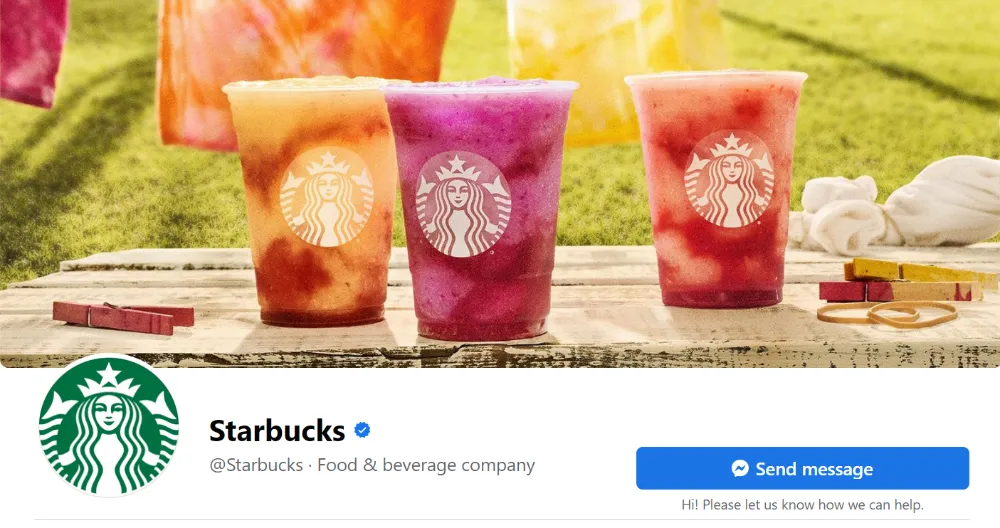
Notice how they’ve also created a particular Instagram aesthetic? Nearly all of their posts follow a green-and-white color scheme.
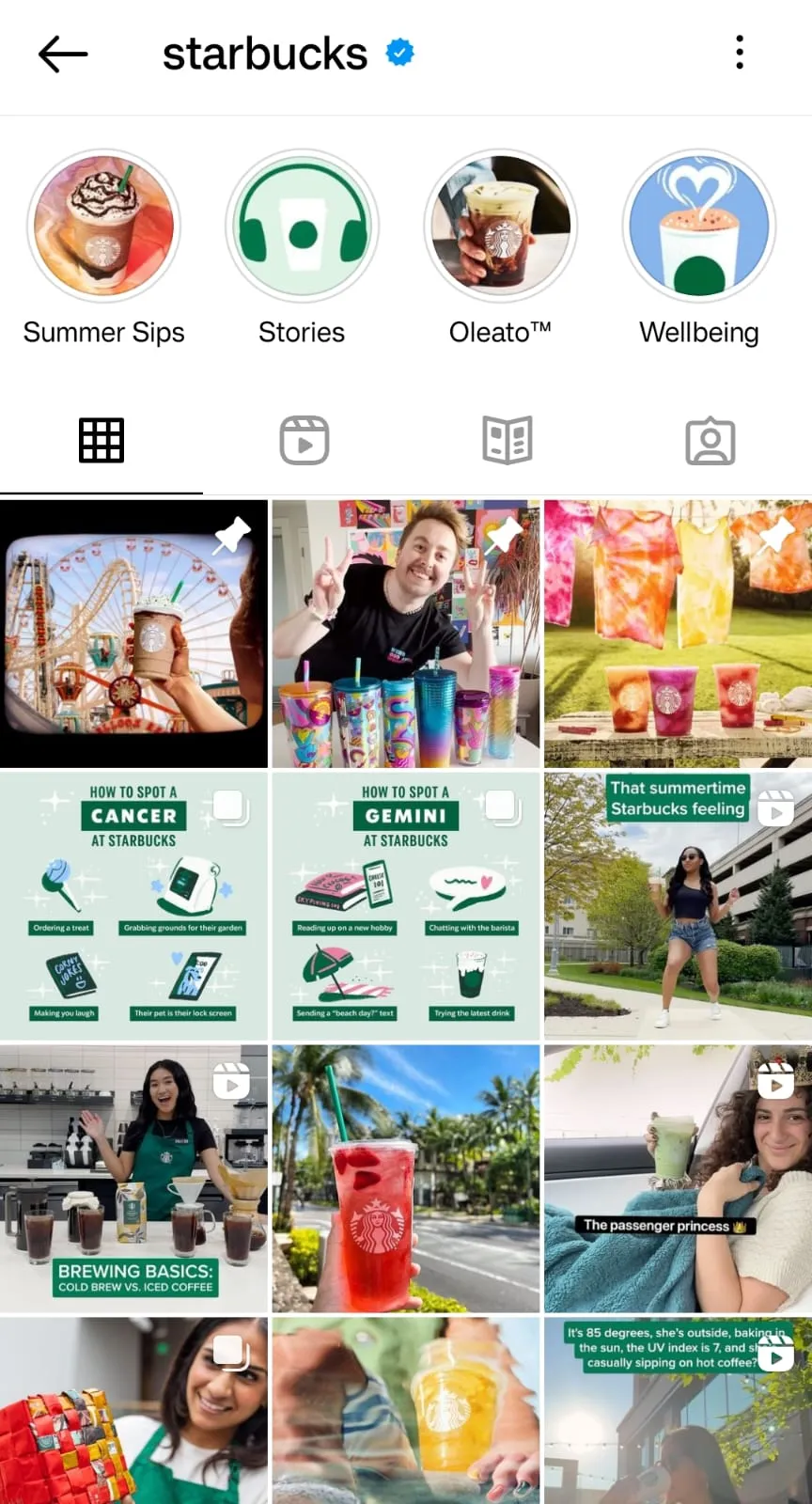
2. Defined Brand Voice and Tone
Do you find yourself using certain catchphrases or vocabulary more frequently on social media? You might be on the path to establishing your brand voice. Your brand voice is communicated through your social media copy and graphics. Whether it’s formal, informative, or super-cheeky, it mirrors your brand’s personality. Simultaneously, your tone influences how your customers feel when interacting with your brand.
However, being supportive on Facebook and sarcastic on Twitter would only sow confusion among your customers.
Take McDonald’s, for example. Their brand voice is consistently fun across all social platforms. They use colloquial abbreviations like ‘LOL’ and ‘BTW’ across their social media profiles to create a conversational tone. To maintain their brand personality, they’ve even updated their profile picture to feature Grimace.
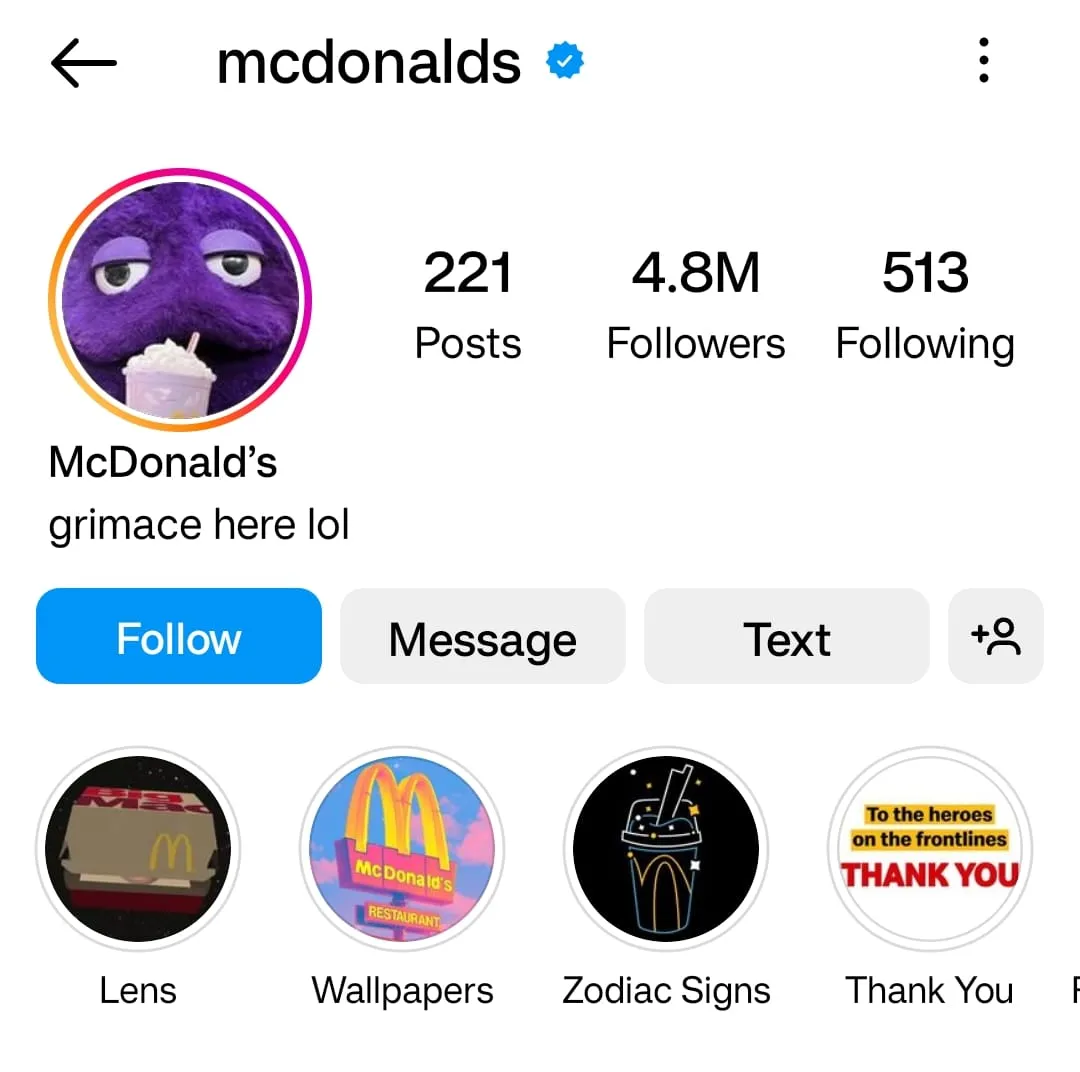
Even the tone in which they reply to comments is laid-back and casual.

3. Engaging Content
Your social media branding strategy includes the type of content you produce. The content should not only adhere to your brand guidelines but should also resonate with your target audience.
When you think of an energy drink brand like Red Bull, for example, what’s the first thing that comes to mind? Adventure, right? So, to cater to their adventure-craving audience, Red Bull shares visually stunning, action-packed content on Instagram, like this Reel below.

In fact, their entire Instagram post grid features content on adventure sports, signifying just what their brand is about – energy.
4. Active Community Engagement
Regular posting on all your social media profiles is a given. But your social media branding journey doesn’t stop there! You need to actively tune into your audience’s conversations and engage with them.
Are they expressing a desire to see a specific type of post or one featuring a particular product? Share such posts across all your social channels. Has someone left a negative review for your brand? Extend your apologies and see if you can transform their negative experience into a positive one.
By making them feel heard, you’re laying the foundation for building a loyal community around your brand.
5. Use of Relevant Platforms
Are you juggling Twitter, Instagram, Facebook, LinkedIn, TikTok, Snapchat, YouTube, and other social media platforms simultaneously? If so, you might find yourself burning out before long.
While social media branding might seem straightforward initially, it requires significant time and effort. To avoid exhaustion, it’s essential to select the right social media platforms for your brand. But how do you go about it?
The answer lies in understanding your target audience’s preferences. In other words, identify where they’re most active – is it LinkedIn, TikTok, Facebook, or elsewhere? For instance, if you’re in the food and beverage industry, LinkedIn might not be your go-to platform.
Next, align your overall business goals with your social media objectives. Are you aiming to build brand awareness, generate leads, or drive website traffic? Choose the social media channels that can help you achieve these goals.
Lastly, keep an eye on your competitors’ social media activities – the platforms they’re using, the content they’re posting, and their performance. If they’re doing well on a specific platform, you wouldn’t want to miss out on the action, would you?
6. Optimized Profiles
Optimizing your social media profiles ensures your brand makes a good first impression on a profile visitor. It’s the first step towards strengthening your brand’s credibility and boosting engagement.
Here are some tips to optimize your profiles:
- Upload a clear profile picture (it may be your logo or a photo signifying your brand personality).
- Use a cover photo complements your profile picture on Facebook, LinkedIn, and Twitter.
- Write an engaging bio that hints at what your brand voice and tone are like.
- Insert a link to your website or product page.
- If you have a physical store, add the address.
- Highlight your latest products.
Look at how Nike checks all the boxes above in their Instagram profile.
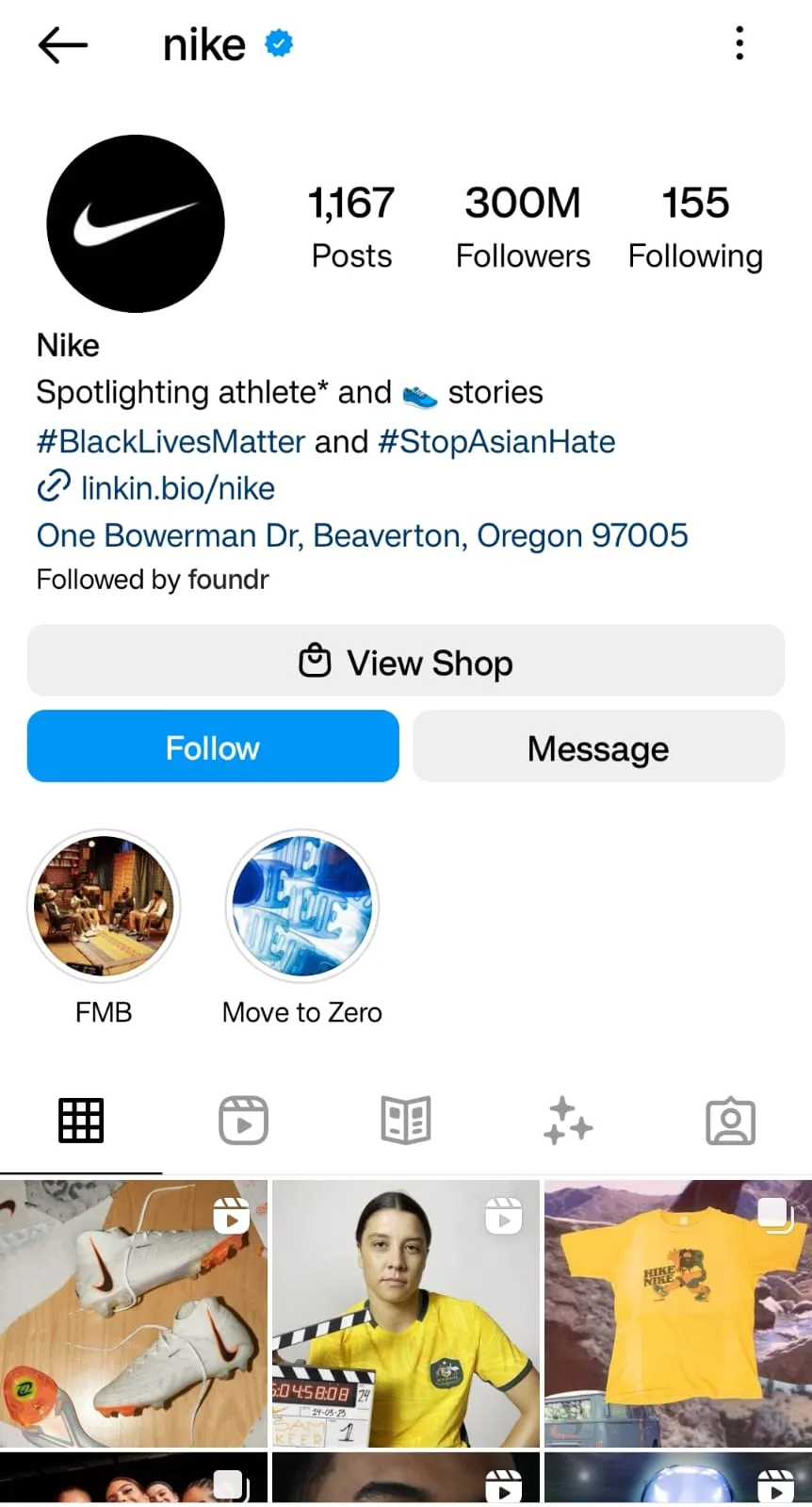
That is to say, their profile picture features their famous swoosh logo, and their bio has the address of Nike World Headquarters, along with a link to their website. Plus, reading their one-line bio description instantly tells you they’re a brand for running shoes. They’ve also set up an Instagram Shop for their products, which you can visit by clicking the ‘View Shop’ button.
Most social platforms offer a range of native features and tools to enhance your social media branding. For instance, TikTok allows you to schedule posts from 15 minutes to 10 days in advance, while Instagram lets you plan up to 75 days ahead.
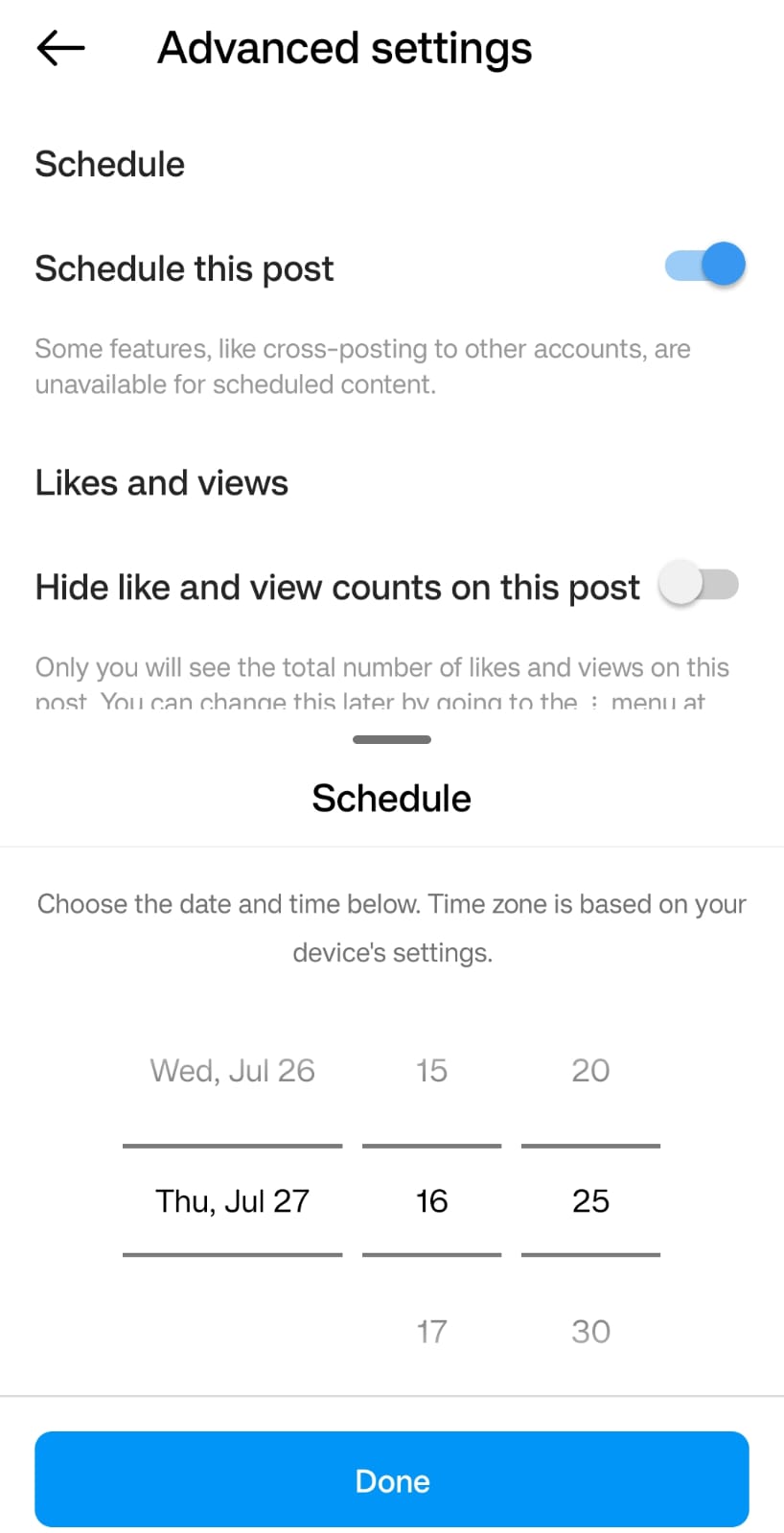
Scheduling posts using these platform-specific tools helps you devise a cohesive timetable, especially useful if your brand operates multiple social media accounts. This way, even if you lose track of important events, you can create content in advance and ensure it gets published on the designated date.
You can also leverage social media analytics tools like SocialPilot to understand your audience better and boost engagement. Meta Business Suite, for example, provides detailed insights about your content and audience on Facebook and Instagram, as does LinkedIn Analytics for each post and page.
But how does analytics tie into engagement? Let’s unravel this.
8. Regular Monitoring and Updating
Even if your posting frequency on social media is low, never cease tracking your brand’s performance. This will help you determine whether your strategies need tweaking. For example, if your brand’s conventional messaging isn’t resonating with your audience and expanding your reach, it might be time to up your game.
Look at these audience insights below from Meta Business Suite for a certain brand’s page.

It’s clear that most of the brand’s audience falls within the 18 to 34 age range. Content tailored to those in their 60s is unlikely to hit the mark here. Therefore, listening to your audience and regularly monitoring your social performance will help you gauge whether they’re aligning with your branding strategy.
Speaking of scheduling and analytics, it can be cumbersome to access each platform’s native tools to do these. But what if there were a simple, all-in-one social media management tool to do it with ease from one single dashboard?
Enter SocialPilot! Your go-to social media management tool that will take care of your social media management and branding. The tool has a plethora of features, from scheduling to analytics to even an AI assistant creates social media posts faster and seamlessly publishes across channels. This one tool will seamlessly work with all your major social media accounts.

However, your audience might tire of seeing the same type of content from your brand. Why not introduce new faces?
9. Collaborations and Partnerships
Do you know the secret ingredient behind Daniel Wellington’s rise as a watch brand? It’s their strategy on social media, particularly Instagram.
Founded in 2011, the brand decided to harness the power of collaborations with Instagram micro-influencers boasting about 5K followers. They gifted these influencers a watch in exchange for a post about their products.
As their brand grew, so did user-generated content (UGC) featuring their watches. In fact, they still encourage their customers and followers to post pictures using the hashtag #danielwellington.

This is why effective social media branding should also encompass collaborations with key personalities and social media influencers.
Ask yourself these questions to pick the right ones to partner with:
- What niche does the influencer cater to?
- What’s your budget?
- What’s their personality like?
For instance, Samsung Canada’s Instagram collaboration with a travel photographer to promote their phone protection gear is a perfect example of a well-aligned partnership.

10. Clear and Concise Messaging
Your communication with your audience is a crucial part of your social media branding strategy. This includes your social media captions, comments, and DMs or private messages. Regardless of the format, your brand’s message should be clear and easily comprehensible.
Take this tweet by Pringles, for example. It playfully promotes their brand to both parents and kids ahead of Halloween.

It’s a perfect example of how to keep your social media messaging brief and to the point. Upon reading this tweet, parents might be inspired to hand out Pringles instead of candy to trick-or-treaters!
In this section, we’ll cover five actionable tips to help you effectively connect your branding with your social media goals.
Consistency is the cornerstone of your branding, and a social media style guide is the foundational brick for that consistency.
Every company should possess a comprehensive guide that outlines the brand’s voice, tone, and visual elements (like logo, typography, and color palette) to be employed on its social media profiles. This guide essentially documents your brand’s dos and don’ts.
You can use this guide as a reference for all your future social media communications, ensuring your entire team is on the same page about your social media guidelines.
Here’s what your brand style guide for social media should include:
- A list of all the social platforms you use.
- A list of all your social media accounts (if you have multiple ones). This will help ensure your brand name is consistent across all channels.
- A clearly-defined brand voice and tone. Note the kind of vocabulary you’ll use in your posts. For instance, mention how many emojis you’ll utilize, on which platforms, and how often. Will you use technical jargon or easy-to-understand language? Are you going to add GIFs or stickers in your posts? Will your tone be formal or sassy? Should you use abbreviations at all?
- Your logo. This will help you ensure you use the same logo across all social channels. Also, note if you’ll change your logo design during significant events. For example, many brands upload their Pride logos to commemorate Pride Month every year.
- Fonts and color palette. Set down the hex codes of the colors to use in various contexts. For instance, you might consider using a darker blue for your CTAs and a softer blue for backgrounds.
- Images. State what kinds of images you’ll be uploading on social media. Will you use stock photos, UGC, or photos you take on your own? Are you going to add any image filters? If so, which ones?
- Post frequency. How often will you reach out to your audience?
- Hashtags. Define a specific hashtag strategy outlining which hashtags to use, when, and how many. Also, include a list of campaign-related and branded hashtags.
- Your audience personas. Develop your target audience personas to create social media content appealing to your target market. List their demographics (age, gender, and location), hobbies, pain points, and what kind of content they engage with the most on social media.
University of North Carolina Greensboro’s social media style guide is a perfect example.

Social listening involves tracking your brand mentions, keywords, industry trends, and customer feedback on social media. It also includes an analysis to gain valuable insights into emerging trends, audience behavior, and sentiment. These insights then appear as new opportunities to improve your social media branding.
Here are some social media listening tips that might come in handy for your brand:
- Select brand-related topics and keywords to monitor. This will help you pinpoint the topics your audience engages with the most. Keywords associated with your industry will also help you find and monitor your competitors.
- Track direct mentions of your brand, as well as your product names.
- Spot your customers’ pain points to understand if there are any gaps in your offering. Identifying their problems will help you address those so your customers are satisfied.
- See if your customers are talking about how they want their issues solved – which is basically half your work done for you!
- Respond in a timely fashion to both positive and negative feedback or comments.
3. Create a Content Calendar
A social media content calendar is a tool used to plan and organize your brand’s social media posts. It lets you see the big picture at a glance – which content types will go live on which social platform in the upcoming weeks or months.
When creating a social media calendar, you’ll want to include the following information for each post:
- The time, date, and day of the week the post will be published
- The topic or theme of the post (let’s say, a generic educational theme, a product specification, or an event announcement)
- The format of the post (whether it’s going to be a video, Story, or an in-feed post)
- The post copy
- Any images, GIFs, videos, or links that will go live with the post
- Who’s creating the post (if multiple people are responsible for your social media branding)
- The social media platform on which you’ll publish the post
- The account you’ll share the post on, in case your brand has multiple accounts on the same social network
- The hashtags you’ll use when posting
- The status of the post (if it’s scheduled, published, or in progress)
- The link to the published post
Coordinating your social media content this way ensures you don’t miss deadlines or big events. You can maintain a consistent posting schedule and plan new, engaging content around seasonal events and holidays. It also helps you check if you’re posting a balanced mix of different content types.
This is what a social media calendar of Wendy’s for June 2023 would look like on a spreadsheet:

A visually appealing calendar like this also helps you track your social media posting strategy.
For example, one glance at the calendar above will tell you that the strategy of Wendy’s for June 2023 has focused more on Facebook and rarely on LinkedIn. Also, they’ve posted images more than any other content format. It may be so because Facebook and image-based content have worked well for them. See how you’re already slicing and dicing the social media calendar?
4. Leverage User-Generated Content (UGC)
User-generated content (UGC) is any content people create about your brand. Since this kind of content is authentic, coming directly from your customers, it’s the most powerful content you can share on social media. That’s because people are more likely to trust content from others than from a brand.
Furthermore, creating UGC allows your customers to participate in your brand’s growth. It also helps you build trust among your audience and let them be a part of an engaged community around your brand.
Here are some actionable tips to encourage and share UGC for your brand:
- Run a hashtag contest asking your audience to create a particular kind of content using your brand’s hashtags.
- Create a branded hashtag and keep reminding your audience to use it.
- Tag your customers in the post or mention them in the caption when reposting your customers’ content about your brand. This will make them feel important enough to want to create more UGC for your brand.
- Organize giveaways, asking people to create UGC to win your product.
- Offer a discount to the person who shares the best UGC for your brand.
For example, Apple asks its customers to share content on Instagram using the hashtag ‘#ShotoniPhone’. They then share the UGC created by their iPhone customers with that hashtag.

5. Test, Analyze, and Adjust
How can you determine which of your social media strategies is effective? The answer lies in gaining insights into how your social content performs across different channels.
Social media metrics provide the historical data you need to refine your social media branding strategies and enhance their effectiveness. From improving your strategy to understanding how people interact with your brand on social media, these metrics can help you comprehend every single detail.
But first, you need to identify which metrics are most crucial to your brand, depending on your social media goals. Let’s explore some of the key social metrics to track and analyze for your brand:
- Impressions
This metric indicates the number of times your content appears on someone’s social media feeds. - Reach
This is the number of people who see a post. If your post is reaching a lot of non-followers, that means it’s being shared and is performing well - Engagement rate
What’s the point of having a large follower base if the audience doesn’t engage with your content? That’s the rationale behind measuring the overall engagement rate of your posts and your social media account.More specifically, the total number of engagements your content gets (likes, comments, shares, retweets, reposts, and saves) as a percentage of your total number of followers is your brand’s overall engagement rate.
- Click-through rate (CTR)
This metric measures the number of times someone clicks on your post (ad) to access more content. The additional content can be your website, product page, video, or blog post. A CTR essentially measures the total number of clicks on a post as a percentage of the total number of impressions. The higher the CTR, the more effective your social media post or ad is.
Remember, these metrics are to be used in combination with each other.
For instance, just because a post’s impression count is high, it doesn’t necessarily mean the post is doing well. Despite having a high impression count, the post might have a low engagement rate. This would probably mean that your post wasn’t interesting enough for people to interact with it after seeing it on their feeds.
With these insights and more, you can optimize your future content and social campaigns.
Conclusion
Posting on social media can be an excellent way to build your brand and boost your online presence. But with more and more brands joining the fray, social media branding has never been more critical — and competitive, too.
The key is to stop seeing social media as just a branding tool and start seeing it as a way to truly interact with your audience. Keep your customers interested in your content by humanizing your brand voice. You also need to maintain brand consistency across social platforms.
It’s not going to be a cakewalk, but if you’re patient and take baby steps toward building a compelling brand on social media, it won’t be long before you get there. And if you want to make that process smoother while keeping your brand voice consistent across channels, a tool like SocialPilot can help. Take a look at SocialPilot’s pricing to see which plan fits your branding goals best.


